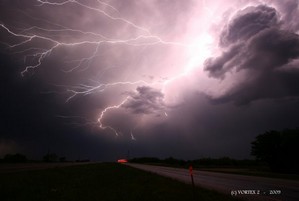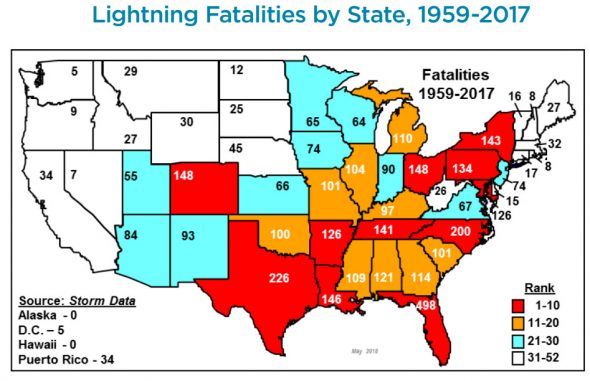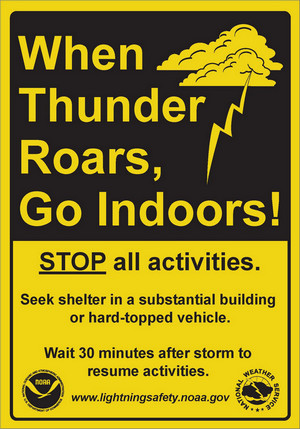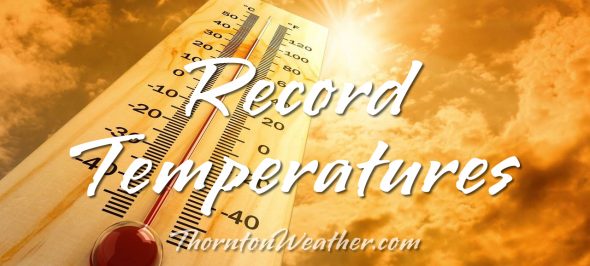
June typically is a very eventful weather month and looking back at this week in Denver weather history that is clearly seen. Among the more noteworthy items are the 2002 Hayman Fire, a 1965 flood that damaged dozens of bridges in the Denver area and the infamous tornadoes in 1988 that struck near downtown Denver.
1-30
In 2012…it was the hottest June in Denver since weather records began back in 1872. The average temperature for the month was 75.0 degrees which was 7.6 degrees above normal. There were a total of seventeen 90 degree days in the month of June. The highlight of record setting month was a stretch of five consecutive 100 degree days from the 22nd to the 26th. This was only the third time in Denver weather history in which this happened. Two of the high temperatures during the stretch peaked at 105 degrees… which set the all time record for the month of June and tied the all-time maximum temperature for Denver.
11-14
In 1999…damage from several hailstorms in and near metro Denver totaled 35 million dollars. About 17.5 million dollars was from automobile claims with another 17.5 million in homeowner claims. The areas hardest hit by the storms included Castle Rock…Commerce City…Evergreen… And Golden.
12-17
In 2000…two large wildfires developed in the Front Range foothills as careless campers and very dry conditions proved to be a dangerous combination. Strong winds gusting in excess of 60 mph on the 13th fanned the flames… Spreading both wildfires out of control. Winds gusted to 78 mph atop Niwot Ridge near the Continental Divide west of Boulder. The hi meadows wildfire…about 35 miles southwest of Denver…consumed nearly 11 thousand acres and 80 structures…mostly high priced homes. The bobcat wildfire…located about 12 miles southwest of Fort Collins… Consumed nearly 11 thousand acres and 22 structures. Late on the 16th…a strong cold front moved south over the great plains into northeastern Colorado. Low level upslope conditions developed in the wake of the front…producing 2 to 4 inches of snowfall overnight at elevations above 8 thousand feet. Firefighters were able to contain both fires shortly thereafter.
13
In 1956…a microburst caused a brief wind gust to 59 mph at Stapleton Airport.
In 1957…an unconfirmed tornado appeared to touch the ground in the vicinity of Franktown. No damage was reported from the twister.
In 1968…a violent gust of wind…possibly associated with a thunderstorm…caused 75 hundred dollars damage in Boulder.
In 1973…hail…1/2 to 3/4 inch in diameter…fell over Lakewood. Flash flooding occurred in west Denver from the same storm.
In 1974…a thunderstorm wind gust to 64 mph was recorded at Stapleton International Airport.
In 1977…hail the size of table tennis balls…1 1/2 inches in diameter…was reported in Boulder.
In 1981…large hail to golf ball size fell in Denver… Northglenn…and Brighton. Hail as large as baseballs was reported in Federal Heights.
In 1984…one of the worst hailstorms ever experienced in metro Denver struck the northwestern suburbs of Arvada…Wheat Ridge…and Lakewood…but large hail also fell in Golden… Southeast Denver…and Aurora. Homes and other buildings sustained around 200 million dollars in damage. Thousands of cars were battered by giant hailstones…and total damage to vehicles was estimated at 150 million dollars. In some areas…golf ball size hail fell continuously for 30 to 40 minutes. Some places were pelted with a few stones as large as grapefruits! Roofs on thousands of structures were severely damaged. Uncounted car windshields were broken; two-thirds of Arvada’s police cars were rendered inoperable. Torrential rains…with as much as 4.75 inches in Lakewood clogged drains and caused widespread damage from flooding. In some places hail was washed into drifts several feet deep. About 20 people were injured by the giant hailstones. One couple was hospitalized. A woman drowned when she was trapped under a trailer by high water. Only pea size hail fell at Stapleton International Airport.
In 1988…2 inch hail fell in Parker. Soft hail 1 inch in diameter fell at the mouth of turkey creek canyon 5 miles southeast of Morrison. Hail between 1 inch and 1 3/4 inches fell at both Bennett and Strasburg. A tornado touched down briefly at Strasburg. A brief funnel cloud was sighted by national weather service observers 15 miles southwest of Stapleton International Airport.
In 1991…a Boulder man was injured when struck by lightning while in a tent. He received only minor burns.
In 1997…lightning struck a home in Denver. The extent of the damage was unknown. A home in Littleton was also struck. The house caught fire…but the extent of the damage was not known.
In 1998…a strong mountain wave produced a brief period of high winds along the Front Range. A small building atop squaw pass west of Denver was blown down. Tree limbs were downed across metro Denver. Peak wind gusts included: 80 mph on squaw pass…69 mph at Jefferson County Airport near Broomfield…and 60 mph in Westminster and at the National Center for Atmospheric Research in Boulder. West-northwest winds gusted to 51 mph at Denver International Airport.
In 2001…high winds developed briefly in Boulder County. A peak wind gust to 76 mph was recorded at the National Center for Atmospheric Research atop the mesa in Boulder. A wind gust to 72 mph was recorded at southern hills middle school in Boulder. Lightning started a small fire…which damaged the roof of a house in Greenwood Village.
In 2009…severe thunderstorms produced hail up to one inch in diameter near Arvada and byers…as well as 7 miles north-northwest of Front Range airport near watkins.
13-14
In 2006…the high temperature of 99 degrees on the 13th equaled the record maximum temperature for the date first set in 1994. The high temperature of 102 degrees on the 14th was a new record maximum temperature for the date.
14
In 1877…an evening thunderstorm produced lightning which struck several houses and killed a cow in the bottom land of the South Platte River
In 1886…hail as large as 3/4 inch in diameter fell in the city. Precipitation was only 0.10 inch.
In 1887…south winds were sustained to 41 mph.
In 1900…a thunderstorm produced northwest winds to 51 mph with gusts to 61 mph…but only a trace of rain.
In 1923…a severe thunderstorm pelted the city with hail. The stones ranged in diameter from 0.2 to 0.8 inch. Gardens and greenhouses suffered considerable damage. Rainfall was only 0.14 inch downtown.
In 1960…one workman was killed and 4 others injured in Lakewood when a partly built apartment building collapsed in strong winds. Microburst wind gusts to 54 mph caused some blowing dust at Stapleton Airport.
In 1967…tornadoes touched down briefly 3 miles west of Franktown and 4 miles northeast of Parker. No damage was reported. Numerous funnel clouds were reported over south metro Denver…one 5 miles south of Denver…one 2 to 3 miles north of Castle Rock…and two near Littleton.
In 1968…a microburst wind gust to 52 mph was recorded at Stapleton International Airport.
In 1972…1 3/4 inch hail was reported in wheat ridge.
In 1976…high winds…unusually strong for this late in the season…raked metro Denver. Wind gusts estimated to 100 mph tore 24 boats from their moorings and damaged a total of 47 boats at Boulder reservoir. Wind gusts to 82 mph were recorded in Boulder. The strong winds toppled the wind mast at a radio station in Boulder. An automobile was smashed by a fallen tree in Boulder. Other damage in Boulder was minor…but power outages occurred when tree limbs fell on power lines. At Jefferson County Airport near Broomfield…wind gusts to 78 mph were recorded with 87 mph gusts clocked at Rocky Flats nuclear plant south of Boulder. Wind gusts to 66 mph were observed in Littleton… And northwest winds gusted to 46 mph at Stapleton International Airport. The strong winds collapsed a barn near Arvada. Several horses received minor injuries. Thirty trees were uprooted or broken in Denver. Four major power outages occurred from west Denver and Lakewood to the foothills.
In 1982…the worst hailstorm in 17 years struck Commerce City. The storm left 4 to 8 inches of hail on the ground. A few of the stones were as large as golf balls. Many vehicles were dented…and some windshields were shattered. Roofs of homes were damaged. Total damage was estimated at over one million dollars. Hail to 1 inch in diameter also fell in Littleton. Only 1/4 inch hail was measured at Stapleton International Airport.
In 1988…lightning ripped a small hole in the roof of a home in the southern part of Boulder. There were some power outages in the area.
In 1992…an off duty national weather service employee reported hail to 1 inch diameter in Westminster.
In 1997…one inch diameter hail fell in Bennett…and 3/4 inch hail was measured in Littleton.
In 1999…hail as large as 1 1/2 inches in diameter hit Aurora. Lightning sparked two small fires at separate residences near the Hiwan Country Club in Evergreen.
In 2004…lightning sparked two small fires near Jamestown. One was in Geer Canyon and the other 7.5 miles up sunshine canyon. Both were quickly contained and caused no damage to structures in the area.
In 2009…a complex of severe thunderstorm produced large hail damaging thunderstorm and funnel clouds across parts of the urban corridor. The line formed along a boundary over the western suburbs of Denver then moved east. The boundary produced at least one well defined funnel cloud that could be observed by stadium full of baseball fans at Coors Field. Large hail…up to 1 3/4 inches in diameter…was reported in Arvada…Broomfield…Denver…Federal Heights and Northglenn. In addition…the storm produced peak wind gusts from 60 to 74 mph. At Denver International Airport…a peak wind gust to 58 mph was observed from the west-northwest.
In 2014…severe thunderstorms broke out across the Urban Corridor. Large hail…ranging in size from 1 to 2 inches in diameter…was observed. The area extended from around Englewood to Aurora and included: Brookridge…Cherry Knolls… Greenwood Village and south Denver. As many as 212 thousand residences were potentially impacted by the storms. The hail shattered windshields and damaged vehicles.
Continue reading June 13 to June 19: This week in Denver weather history →






 Extreme weather can occur during in month in Colorado we well know. June however is when traditional spring severe weather arrives in the state oftentimes with hail, damaging wind and tornadoes.
Extreme weather can occur during in month in Colorado we well know. June however is when traditional spring severe weather arrives in the state oftentimes with hail, damaging wind and tornadoes.